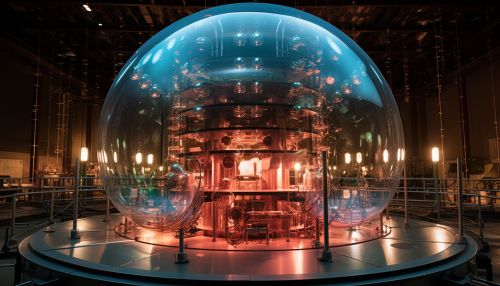Neutrino experiment
Introduction
The field of particle physics has been revolutionized by the discovery and study of a subatomic particle known as the neutrino. Neutrinos are elementary particles that interact only via the weak subatomic force and gravity. They are neutral particles, hence the name 'neutrino', which means 'little neutral one' in Italian. The study of neutrinos and their properties is conducted through neutrino experiments, which have provided significant insights into the fundamental nature of matter and the universe.


History of Neutrino Experiments
The existence of neutrinos was first proposed by Wolfgang Pauli in 1930 to explain the continuous energy spectrum of beta decay. The first neutrino experiment that detected neutrinos was conducted by Clyde Cowan and Frederick Reines in 1956, an experiment known as the Cowan–Reines neutrino experiment. This experiment used a nuclear reactor as a source of neutrinos and was able to detect the presence of electron antineutrinos. The discovery of neutrinos was a significant milestone in particle physics and earned Reines the 1995 Nobel Prize in Physics.
Types of Neutrino Experiments
Neutrino experiments can be categorized based on the source of neutrinos they use. These include:
- Reactor Experiments: These experiments use nuclear reactors as a source of antineutrinos. The Cowan–Reines neutrino experiment was a reactor experiment.
- Accelerator Experiments: These experiments use particle accelerators to produce neutrinos. The DONUT experiment was an accelerator experiment that provided the first direct observation of tau neutrinos.
- Atmospheric Neutrino Experiments: These experiments detect neutrinos produced by cosmic rays interacting with the Earth's atmosphere. The Super-Kamiokande experiment is a notable atmospheric neutrino experiment.
- Solar Neutrino Experiments: These experiments detect neutrinos produced by nuclear fusion in the Sun. The Homestake Experiment and the Sudbury Neutrino Observatory are examples of solar neutrino experiments.
Neutrino Detectors
Neutrino detectors are the primary tool used in neutrino experiments. They are designed to detect the weak interactions of neutrinos with matter. There are several types of neutrino detectors, including:
- Water Cherenkov Detectors: These detectors, such as the Super-Kamiokande, use large volumes of water to detect the Cherenkov radiation produced by charged particles moving faster than the speed of light in water.
- Scintillation Detectors: These detectors use a scintillating material that emits light when a neutrino interacts with it. The Borexino experiment uses a scintillation detector.
- Radiochemical Detectors: These detectors, such as the Homestake Experiment, use a chemical reaction triggered by neutrino interactions to detect neutrinos.
- Liquid Argon Time Projection Chambers (LArTPCs): These detectors, like the MicroBooNE experiment, use liquid argon to detect neutrino interactions.
Neutrino Oscillations
One of the most significant discoveries in neutrino experiments is the phenomenon of neutrino oscillations, which was first observed by the Super-Kamiokande experiment and the Sudbury Neutrino Observatory. Neutrino oscillations occur when neutrinos change from one flavor (electron, muon, or tau) to another as they travel. This phenomenon implies that neutrinos have mass, which was not predicted by the original Standard Model of particle physics. The discovery of neutrino oscillations has had profound implications for our understanding of the universe and has led to the development of the field of neutrino astronomy.
Current and Future Neutrino Experiments
Current neutrino experiments aim to further our understanding of neutrino properties and their role in the universe. These include experiments like the Deep Underground Neutrino Experiment (DUNE), which aims to study neutrino oscillations in detail and search for CP violation in the neutrino sector. Future neutrino experiments aim to answer fundamental questions in particle physics, such as the nature of neutrino mass and the possibility of neutrinos being their own antiparticles.
